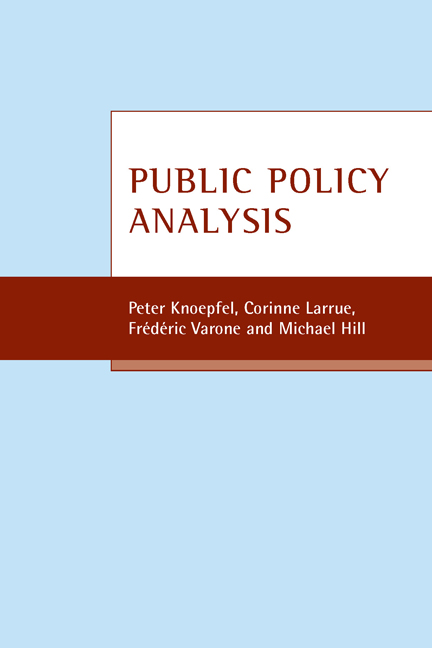Part II - Keys to the analysis
Published online by Cambridge University Press: 14 January 2022
Summary
In this second section, we present the prerequisites of our policy analysis model. We also define the concepts necessary to our analysis.
More precisely, our approach focuses on the individual and collective behaviour of the actors involved in the different stages of a policy. Thus, we assume that the content and institutional characteristics of a public action (the variable to be explained) are the product of the interaction between the political-administrative authorities, on the one hand, and the social groups that cause and/or support the negative effects of the collective problem that the public action seeks to resolve (explanatory variables), on the other. Apart from respective values and interests, the ‘games’ these actors play are dependent on the resources they succeed in mobilising so as to defend their positions with respect to the objectives, instruments and development process involved in a public intervention measure. These games can affect equally the substantive content of the public policy and the procedural and organisational modes of its formulation and implementation. In all of these cases, however, the actors must take into account the constraints and opportunities constituted by the institutional rules in force. The (meta) rules established at constitutional level and hence theoretically applicable to all policies, predetermine the more specific rules associated with a specific policy. The latter directly influence an actor's access to both this policy arena and the action resources that can be mobilised. If these specific institutional rules pre-structure the actors’ game, it should be kept in mind that they too are (partly) negotiated, mainly during policy formulation, by the actors who are (potentially) affected by the substantive targeted results.
Figure 1 summarises the key elements of the public policy analysis model adopted in this manual.
Before we explore all of the possible relationships between actors, resources and the institutions involved in a given policy, we must define exactly what we mean by these concepts.
Chapters Two to Five provide responses to four fundamental questions: what are the constituent elements of a public policy (Chapter Two)? How can the different categories of public policy actors be identified and characterised (Chapter Three)? What are the different types of resources that the actors can mobilise to influence the content and development of a policy (Chapter Four)?
- Type
- Chapter
- Information
- Public Policy Analysis , pp. 17 - 20Publisher: Bristol University PressPrint publication year: 2007



